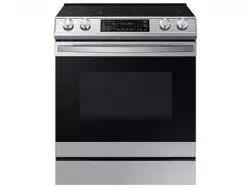Documents: Go to download!
User Manual
- User Manual - (English, French, Spanish)
- Warranty - (English)
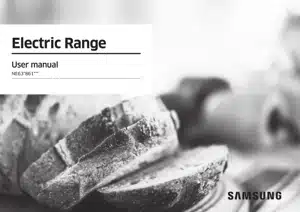
- Introducing your new range
- Surface cooking
- Operating the oven
- Maintaining your appliance
- Troubleshooting
Table of contents
User Manual Range
Introducing your new range

01 Touch display
02 Surface control knobs (See page 23 for more information.)
03 Vent
04 Oven door
05 Storage drawer
06 Broil oven heater
07 Oven light
08 Convection system
09 Shelf position
What’s included
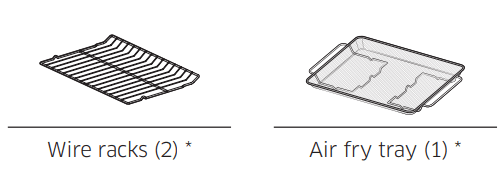
Surface cooking
About induction cooktop cooking
BEFORE COOKING
• Do not use the Induction cooktop surface as a cutting board.
• Do not place or store items that can melt or catch fire on the Induction cooktop, even when it is not being used.
• Turn the induction cooktop on only after placing the cookware on it.
• Do not store heavy items above the cooktop surface. They could fall and damage it.
DURING COOKING
• Metallic objects such as knives, forks, spoons, and lids should not be placed on the induction cooktop surface since they can get hot.
• After use, switch off the induction element using its control. Do not rely on the pan detector.
• Use this appliance for normal cooking and frying in the home only. It is not designed for commercial or industrial use.
• Never use the induction cooktop range to heat the room.
• Take care when plugging electrical appliances into a power outlet near the cooktop. Power cords must not come into contact with the cooktop.
• Overheated fat and oil can catch fire quickly. Never leave surface units unattended when preparing foods in fat or oil, for example, when cooking french fries.
• Turn the cooking zones off after use.
• Never place combustible items on the induction cooktop. It may cause a fire. • Do not use the induction cooktop to heat aluminium foil, products wrapped in aluminium foil, or frozen foods packaged in aluminium cookware.
• There is the risk of burns from the appliance if used carelessly.
• Do not let cables from electrical appliances touch hot cookware or the hot surface of the induction range cooktop.
• Do not use the induction range to dry clothes.
• Never store flammable materials such as aerosols and detergents in the drawer or cupboards under the induction cooktop.
• Users with Pacemakers or Active Heart Implants must keep their upper body at least 1 ft. (30 cm) from the induction cooking zones when they are turned on. If in doubt, you should consult the manufacturer of your device or your doctor.
AFTER COOKING
• Do not touch the Induction elements until they have cooled down.
• The surface can stay hot for some time after cooking is complete. If you touch the surface before it has had time to cool down sufficiently, you can burn yourself.
• Immediately clean spills on the cooking area to prevent a tough cleaning chore later.
• After you have activated elements on the cooktop, the internal fan may come on for cooling purposes.
• The fan activation time may differ depending on the temperature of the internal sensor. (10 minutes or 20 minutes)
• If you have cabinet storage directly above the cooking surface, make sure that the items in the cabinet are infrequently used and can be safely stored in an area subjected to heat. Temperatures may be unsafe for items such as volatile liquids, cleaners, or aerosol sprays.
Location of the induction cooktop elements and controls
The induction control knobs operate the induction surface elements on the cooktop as shown below.

01 Left Rear: 7", 1,800 / 2,300 W
02 Left Front: 7", 1,800 / 2,300 W
03 Right Front: 11", 2,400 / 3,800 W
04 Right Rear: 6", 1,200 / 2,000 W
05 Cooktop display
Safety instructions. Residual heat
• The Cooktop display has a residual heat indicator for each element. It shows which elements are still hot. You should avoid touching an element when this indicator is displayed.
• Even if the Induction cooktop is switched off, the  or
or indicator will stay lit while an element is still hot. The
indicator will stay lit while an element is still hot. The  indicator is hotter than
indicator is hotter than .
.
Digital display
•  Power Boost : Use this setting to heat up the contents of a pot or pan faster than the maximum power level
Power Boost : Use this setting to heat up the contents of a pot or pan faster than the maximum power level  (Hi).
(Hi).
•  Displayed if an element knob was set to an On position after the Sabbath or Self-clean mode has ended or been cancelled, and the range was not able to detect a pot or pan on the burner within one minute. To return the display to normal and use the cooktop, set the knob to the Off position.
Displayed if an element knob was set to an On position after the Sabbath or Self-clean mode has ended or been cancelled, and the range was not able to detect a pot or pan on the burner within one minute. To return the display to normal and use the cooktop, set the knob to the Off position.
•  Error message. Displayed if the Induction cooktop has overheated because of abnormal operation. Example : Operating with empty cookware.
Error message. Displayed if the Induction cooktop has overheated because of abnormal operation. Example : Operating with empty cookware.
•  Error message. Displayed if the cookware on an element is unsuitable, too small, or if no cookware has been placed on the cooking zone.
Error message. Displayed if the cookware on an element is unsuitable, too small, or if no cookware has been placed on the cooking zone.
•  Displayed when the Sabbath or Self-clean mode is operating.
Displayed when the Sabbath or Self-clean mode is operating.
How to set the appliance for cooktop cooking
Induction cooktop control knob
1. Push the knob in.
2. Turn in either direction to the setting you want.
3. The digital displays will show 
 or
or  .
.
• Move the Knob dial until the desired power level setting appears in the digital display:  to
to (Hi),
(Hi),  (Boost).
(Boost).

Induction power boost control
1. To use the Power boost setting, turn the control knob directly to the "9/Boost" setting.
2. The digital display will show .
.
• The power boost function makes additional power available to the induction cooking zone when you need it. Example: To bring a large volume of water to a boil.
• The power boost function is activated for a maximum of 10 minutes for each cooking zone. After Power Boost is finished, the cooking zones automatically return to power level .
.
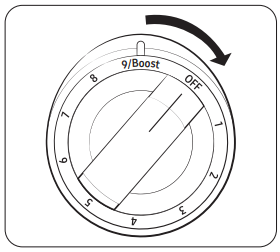
Induction simmer control
1. To use the Simmer setting, turn the control knob to 1.
2. The digital display will show .
.
• Use Simmer to simmer and keep large quantities of foods such as stews and soup warm.
• The simmer setting of the small cooking zone is ideal for delicate foods and melting chocolate.
Cookware for induction cooking zones
Cookware material

Using the correct size cookware
• The Induction Cooking Zones require that you use pots and pans of a minimum size or larger at each location. The inner ring of each Cooking Zone is your guide to the correct minimum pan size. The pan bottom must fully cover the inner ring for proper cooking to occur.
• The thicker outer ring at each Cooking Zone is helpful to determine the maximum pan size. After centering the cookware on the cooktop, make sure the cookware does not extend more than 1/2" beyond the thicker line on the Cooking Zone. The pan must fully contact the glass surface without the bottom of the pan touching the metal cooktop trim.
Pot and pan sizes
Induction cooking zones adapt automatically to the size of the bottom of the cookware up to a certain limit. However the magnetic part of the bottom of the cookware must have a minimum diameter depending upon the size of the cooking zone
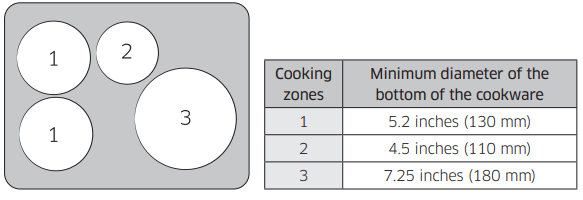
Induction cookware test
You can test whether cookware is most efficient for induction cooktop.
1. Press and hold(3secs) the Timer and  at the same time.
at the same time.
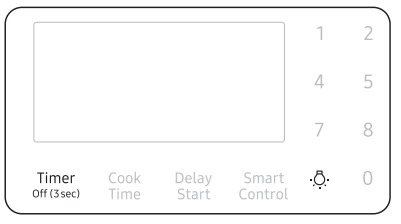
2. If you enter test mode, your cooktop display will appear like the image on the left.
3. Put your cookware on an induction cooking zone, and turn each knob one by one that you want to test to Boost or 1 - 9. Example: If the cookware you want to test is on the Right Front cooking zone, turn the Right Front knob.
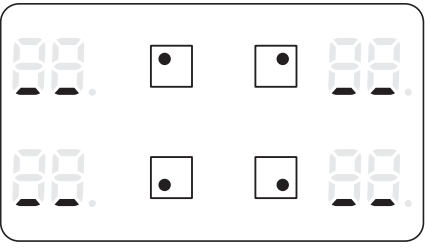
4. After analyzing, the result will be shown on the cooktop display.
•  That cookware can not be used
That cookware can not be used
•  That cookware is usable but less efficient
That cookware is usable but less efficient
•  That cookware is most efficient
That cookware is most efficient
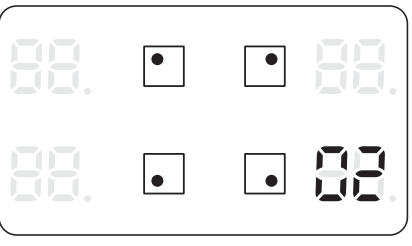
5. After few seconds, you can try again 2 - 4.
6. To finish this test, Turn all knob to OFF.
Operating noises
You may hear the following operational noises:
• Cracking noises : You may hear a cracking noise when you are using cookware made of two or more materials.
• Whistling : A whistling noise occurs when both back burners are in use. This is caused by vibrations. Whistling can vary depending on the weight or material of the cookware or the type of food you are cooking. (Noise can be reduced by using thicker cookware.)
• Humming : You may hear a low humming when you set an element to a high power setting. This sound is generated by energy transmission, and it will disappear when cooktop is turned off.
• Clicking : Electric switches are operating.
• Hissing, Buzzing : You may hear a fan noise during cooktop/oven operation. You may continue to hear it even after the cooktop/oven is turned off. This is normal. The fan runs to cool down the temperature inside. It will automatically shut off itself after a short period of time. These noises are normal and do not indicate any defects.
Using suitable induction cookware
Suitability test
Cookware is suitable for induction cooking if a magnet sticks to the bottom of the cookware and the cookware is labelled as suitable by the cookware manufacturer.
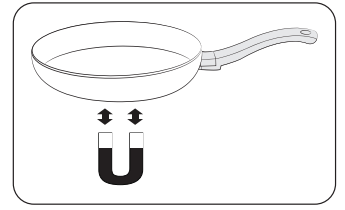
Better pans produce better results
• You can recognize good pots and pans by their bases. The base should be as thick and flat as possible.
• When buying new pots or pans, pay particular attention to the diameter of the base. Manufacturers often give only the diameter of the upper rim.
• Do not use pans which have damaged bases with rough edges. You can scratch the ceramic cooktop permanently if you slide a pot or pan with a damaged base across the surface.
• When cold, pan bases are normally bowed slightly inwards (concave). They should never be bowed outwards (convex).
• If you want to use a special type of pot or pan, for example, a pressure cooker, a simmering pan, or a wok, please follow the manufacturer’s instructions.
Energy saving tips
You can save valuable energy by observing the following points:
• Always position pots and pans before switching on the cooking zone.
• Dirty cooking zones and pan bases increase power consumption.
• When possible, position lids firmly on pots and pans so that the lids cover them completely.
• Switch the cooking zones off before the end of the cooking time and use the residual heat to keep food warm.


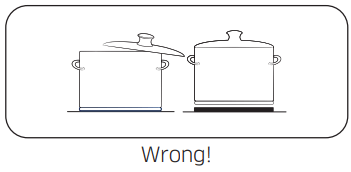
Temperature detection
If for any reason the temperatures on any of the cooking zones exceeds the safety level, then the cooking zone will automatically reduce the heat to a lower power level. When you have finished using the cooktop, the cooling fan will continue to run until the cooktop’s electronics have cooled down. The cooling fan switches itself on and off depending upon the temperature of the electronics.
Power management
The cooking zones, which consist of paired cooking elements, are restricted to drawing a certain maximum amount of power. If you cause a cooking zone to exceed its maximum allowed power by switching on the Power Boost function, the Power Management function automatically reduces the power setting of the two elements in the cooking zone and reduces the power draw.

Suggested settings for cooking specific foods
The figures in the table below are guidelines. The power settings required for various cooking methods depend on a number of variables, including the quality of the cookware being used, the type, and amount of food being cooked.
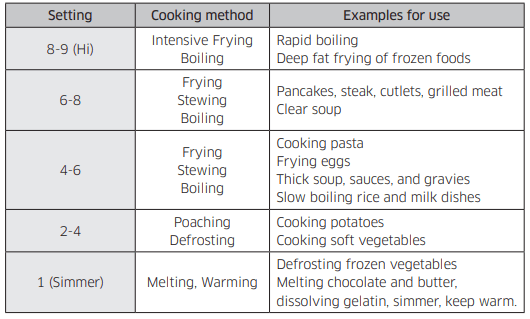
Protecting the cooktop
Cleaning
• Clean the cooktop before using it for the first time.
• Clean your cooktop daily or after each use. This will keep your cooktop looking good and can prevent damage.
• If a spillover occurs while you are cooking, immediately clean the spill from the cooking area while it is hot to prevent a tough cleaning chore later. Using extreme care, wipe the spill with a clean, dry towel.
• Do not allow spills to remain on the cooking area or the cooktop trim for a long period of time.
• Do not use abrasive cleansing powders or scouring pads, which will scratch the cooktop.
• Do not use chlorine bleach, ammonia, or other cleansers not specifically recommended for use on a glass-ceramic surface.
Preventing marks and scratches
• Do not use glass cookware. It may scratch the cooktop.
• Do not place a trivet or wok ring between the cooktop and the pan. These items can mark or scratch the cooktop.
• Make sure the cooktop and the pan bottom are clean.
• Do not slide metal pans across the cooktop.
Preventing stains
• Do not use a soiled dish cloth or sponge to clean the cooktop surface. A film will remain, which may cause stains on the cooking surface after the area is heated.
• Continuously cooking on a soiled surface can result in a permanent stain.
Preventing other damage
• Do not allow plastic, sugar, or foods with high sugar content to melt onto the hot cooktop. Should this happen, clean immediately.
• Do not let a pan boil dry as this will damage the cooktop and the pan.
• Do not use the cooktop as a work surface or cutting board.
• Do not cook food directly on the cooktop. Always use the proper cookware.
Operating the oven
The oven control panel
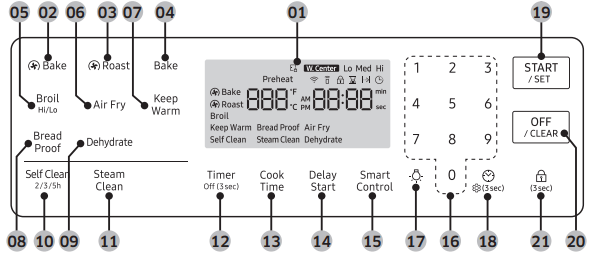
01 Display: Shows the time of day, oven temperature, whether the oven is in the bake, convection bake/roast, broil, or self-cleaning mode, and the time set for the timer or automatic oven operations.
02 Convection Bake: Use to select the Convection bake function of the oven.
03 Convection Roast: Use to select the Convection roast function of the oven.
04 Bake: Use to select the bake function of the oven.
05 Broil: Use to select the broil function of the oven.
06 Air Fry: Use to select the air fry function of the oven.
07 Keep Warm: Use to select the keep warm function of the single oven to keep cooked foods warm.
08 Bread Proof: Use to select the bread proof function of the oven.
09 Dehydrate: Use to select the dehydrate function of the oven.
10 Self Clean: Use to select the Self-cleaning function of the oven.
11 Steam Clean: Use to select the steam cleaning function of the oven.
12 Timer: Use to set or cancel the kitchen timer. The kitchen timer does not start or stop cooking. Press and hold for 3 seconds to turn off the timer.
13 Cook Time: Press and then use the number pad to set the amount of time you want your food to cook. The oven will shut off when the cooking time has run out.
14 Delay Start: Press to set the oven to start and stop automatically at a time you set. (Bake, Conv.bake/Roast, Cooking Time, and self clean only.)
15 Smart Control: Use to select the smart control feature.
16 Number pad: Use to set any function requiring numbers, such as the time of day on the clock, the timer, the oven temperature, the start time and length of operation for timed baking, etc.
17 Lamp: Press to turn the oven light on or off.
18 Clock / Setting : Use to set the time of day. Use to bring up the user preference menu in the display. (Press for 3 seconds.)
19 START / SET: Use to start any cooking or cleaning function in the oven.
20 OFF / CLEAR: Press to cancel all oven operations except the clock and timer. Press to cancel a previously entered temperature or time.
21 Oven lock: Use to disable all oven functions.
Oven lock
Lock the oven controls, cooktop, and oven door so they cannot be activated accidentally. Oven lock can only be activated in standby mode.
How to activate the oven lock feature
Press Oven lock for 3 seconds. The display will show the Lock
for 3 seconds. The display will show the Lock  icon as well as the current time. All functions must be cancelled before Oven lock is activated. This function is available only when the oven temperature is under 400 °F.
icon as well as the current time. All functions must be cancelled before Oven lock is activated. This function is available only when the oven temperature is under 400 °F.
How to unlock the Oven
Press Oven lock for 3 seconds. The Lock
for 3 seconds. The Lock  icon will disappear from the display.
icon will disappear from the display.
Setting the clock
The clock must be set to the correct time of day for the automatic oven timing functions to work properly.
• The time of day cannot be changed during timed cooking, delay-timed cooking, or a self-cleaning cycle.
• You can choose between a 12-hour or 24-hour display. The default is 12-hour.
How to set the clock
1. Press Clock .
.
2. Press Clock to select AM or PM. (Skip this step on 24 hour display setting.)
to select AM or PM. (Skip this step on 24 hour display setting.)
3. Enter the current time in hours and minutes on the number pad, e.g., 1, 3, 0, for 1:30.
4. Press Clock or START/SET to save the changes.
or START/SET to save the changes.
Setting the kitchen timer
The kitchen timer serves as an extra timer that will beep when the set time has elapsed. It does not start or stop cooking functions. You can use the kitchen timer with any of the other oven functions.
How to set the timer
1. Press Timer.
2. Enter the amount of time you want using the number pad, e.g., 1, 5. The timer can be set for any amount of time from 1 minute to 9 hours and 59 minutes. If you make a mistake, press Timer, and then enter the amount of time again.
3. Press START/SET.
4. When the set time has elapsed, the oven will beep and the display will show "End" until you press the Timer pad. You can cancel the timer at any time by pressing Timer for 3 seconds.
Timed cooking
In timed cooking, the oven turns on immediately and cooks for the length of time you select. At the end of the cooking time, the oven turns off automatically.
• You can use the timed cooking feature only with another cooking operation (bake, convection bake, convection roast).
How to set the oven for timed cooking
1. Start the cooking operation you want, e.g., Bake. The default temperature is 350 °F.
2. Press Cook Time.
• You can set the Cook Time at any time. (After selecting the cook mode, during preheating, after preheating.)
3. Enter the cooking time you want, e.g., 45 min, using the number pad. You can set the cooking time for any amount of time from 1 minute to 9 hours and 59 minutes.
4. Press START/SET. The temperature display will start to change once the oven temperature reaches 175 °F. The oven will continue to cook until the set amount of time has elapsed, then turn off automatically unless you set the keep warm feature. (Refer to the section on the keep warm feature on page 41.)
5. You can cancel a cook time at any time by setting the cook time to 0 minutes. (Press Cook Time -> set cook time to 0 min -> press START/SET)
Delay start
In a delay timed cooking, the oven’s timer turns the oven on and off at times you select in advance.
• You can use the delay start feature only with another cooking operation (bake, convection bake, convection roast, self-clean, air fry or dehydrate).
• You can set the oven for a delay start before setting other cooking operations.
• The clock must be set to the current time.
How to set the oven for delay start
1. Position the oven rack(s) and place the food in the oven.
2. Press the pad for the cooking operation you want, e.g., Bake. The default temperature is 350 °F.
3. Enter the temperature you want, e.g., 375 °F, using the number pad.
4. Set the cooking time if you want. (Refer to the section on the timed cooking feature on page 32).
5. Press Delay Start.
6. Enter the time you want the oven to turn on, e.g., 4:30, using the number pad.
7. Press START/SET. At the set time, a short beep will sound. The oven will begin to bake
Turning the oven light on and off
• The oven light turns on automatically when the door is opened.
• The oven light turns off automatically when the door is closed.
• You can turn the oven light on and off manually by pressing the  pad.
pad.
Minimum and maximum settings
All of the features listed in the table below have minimum and maximum time or temperature settings. A beep will sound each time a pad on the control panel is pressed and the entry is accepted. An error tone will sound in the form of a long beep if the entered temperature or time is below the minimum or above the maximum setting for the feature.

Using the oven racks
Oven rack positions

Recommended rack position for cooking

Rack and Pan placement
Centering the baking pans in the oven as much as possible will produce better results. If baking with more than one pan, place the pans so each has at least 1˝ to 1½˝ of air space around it. When baking on a single oven rack, place the oven rack in position 3 or 4. See the figure

Cakes place the oven racks in positions 3 and 5, Cookies place the racks in positions 2 and 5.

Using Multiple Oven Racks

Before using the racks
The oven has two racks. Each rack has stops that need to be placed correctly on the supports. These stops will keep the rack from coming completely out.
REMOVING THE RACKS
1. Pull the rack straight out until it stops.
2. Lift up the front of the rack, and then pull it out.
REPLACING THE RACKS
1. Place the end of the rack on the support.
2. Tilt the front end up and push the rack in

Baking
The oven can be programmed to bake at any temperature from 175 °F to 550 °F. Baking temperature and time will vary depending on the ingredients and the size and shape of the baking pan used. Dark or nonstick coatings may cook faster with more browning.
How to set the temperature
1. Press Bake. The default temperature is 350 °F.
2. Enter the temperature you want on the number pad, e.g., 3, 7, 5.
3. Press START/SET. The temperature display will start to change once the oven temperature reaches 175 °F.
4. If you want to cancel baking or if you have finished, press OFF/CLEAR.
• Place food in the oven after preheating if the recipe calls for it. Preheating is very important for good results when baking cakes, cookies, pastry, and breads. After the oven has reached the desired temperature, the range will beep several times.
How to adjust the temperature while cooking
1. Press Bake. The display will show the present temperature, e.g., 375 °F.
2. Enter the temperature you want, e.g., 425 °F, using the number pad.
3. Complete the entry by pressing START/SET.
Convection baking
By using the convection bake feature, you will be able to cook faster. Convection baking uses a fan to circulate the oven’s heat evenly and continuously within the oven. This improved heat distribution allows for even cooking and excellent results while using multiple racks at the same time. Foods cooked on a single oven rack will generally cook faster and more evenly with convection baking. Multiple oven rack cooking may slightly increase cook times for some foods, but the overall result is time saved. Breads and pastries brown more evenly. You can program the oven for convection baking at any temperature between 175 °F and 550 °F.
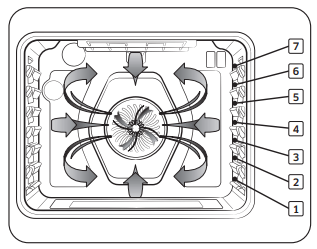
Tips for convection baking
The amount of time you save will vary depending on the amount and type of food you are cooking. When baking cookies or biscuits, you should use pans with no sides or very low sides to allow the heated air to circulate around the food. Using a pan with a dark finish will produce faster cooking times. When using convection baking with a single rack, place the oven rack in position 3 or 4. If cooking on multiple racks, place the oven racks in position 3 and 5 or 2 and 5. When baking a cake, using the bake mode (not the convection bake mode) will produce better results.
How to set the oven for convection baking
1. Press  Bake. The default temperature is 325 °F.
Bake. The default temperature is 325 °F.
2. Enter the temperature you want, e.g., 400 °F, using the number pad.
3. Press START/SET. The temperature display will start to change once the oven temperature reaches 175 °F. The range will beep several times when the oven reaches the adjusted oven temperature.
4. To turn off or cancel convection baking, press OFF/CLEAR.
• The convection oven fan shuts off when the oven door is opened.
• DO NOT leave the door open for long periods of time while using convection cooking or you may shorten the life of the convection heating element.
Convection roasting
Convection roasting is good for cooking large tender cuts of meat, uncovered. Heat comes from the top heating element. The convection fan circulates the heated air evenly over and around the food. Meat and poultry are browned on all sides as if they were cooked on a rotisserie. The heated air seals in juices quickly for moist and tender results while, at the same time, creating a rich golden brown exterior
How to set the oven for convection roasting
1. Press  Roast. The default temperature is 325 °F.
Roast. The default temperature is 325 °F.
2. Enter the temperature you want, e.g., 400 °F, using the number pad.
3. Press START/SET. The temperature display will start to change once the oven temperature reaches 175 °F. The range will beep several times when the oven reaches the adjusted oven temperature.
4. To turn off or cancel convection roasting, Press OFF/CLEAR.
• The convection oven fan shuts off when the oven door is opened.
• DO NOT leave the door open for long periods of time while using convection cooking or you may shorten the life of the convection heating element.
Broiling
Broiling is a method of cooking tender cuts of meat by direct heat under the broil element of the oven. The high heat cooks quickly and gives a rich, brown outer appearance. Broil mode is best for meats, fish, and poultry up to 1" thick. Always preheat the oven for 4 minutes before broiling.
How to set the oven for broiling
1. Press Broil once for Hi or twice for Lo. Use Lo to cook foods such as poultry or thick cuts of meat thoroughly without over-browning them.
2. To start broiling, press START/SET. Broil one side until the food is browned. Turn over and broil the other side.
3. Press OFF/CLEAR once you have finished cooking or if you want to cancel broiling.
Broiling Recommendation Guide
The size, weight, thickness, starting temperature, and your doneness preference will affect broiling times. This guide is based on meats at refrigerator temperature. Always use a broiler pan and its grid when broiling. Always preheat the oven for 4 minutes before broiling.

Air fry
This feature uses hot air for crispier and healthier frozen or fresh foods, such as frozen potato chips, chicken nuggets, chicken wings and so on, without or less oil than normal convection modes. For best results, use this mode on a single oven rack and place the Air fry tray on the position 3. The temperature can be set between 350 °F and 500 °F. Preheating is not necessary for this mode. Follow recipe or package directions for set temperature, time or quantity.
How to set the oven for Air fry mode
1. Place the tray on rack position 3.
2. Select Air fry mode.
3. Use the number pad to change the default temperature. Enter the suggested temperature for your food as recommended cooking guide. The default temperature is 425 °F.
4. Set the Cook Time or Delay Start, if necessary.
5. Tap START/SET.
6. When cooking is complete, tap OFF/CLEAR and take out the food.
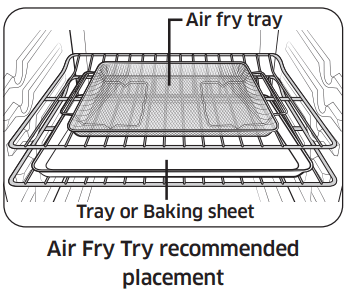
• For cooking fresh or homemade foods, spread the oil over a larger area more evenly, crisping up the food more effectively.
• Place under a few sheets of paper like parchment paper to absorb the fat for reducing splatter and smoke during the Air Fry or Adding water to the tray underneath the basket helps prevent grease from getting smoking.
• Wet or thicken coating will not crisp or set to use with the Air Fry.
Air fry cooking guide

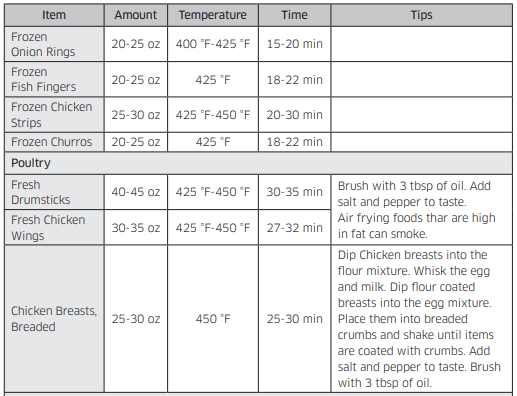
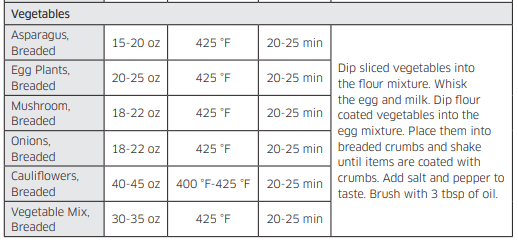
Using the special function
Dehydrate
Dehydrate dries food or removes moisture from food via heat circulation. After drying the food, keep it in a cool and dry place. For fruit, adding lemon or pineapple juice or sprinkling sugar on the fruit helps the fruit retain sweetness. See the table below for Dehydrate settings.
1. Press Dehydrate.
2. Press START/SET.
3. Press OFF/CLEAR at any time to turn off the Dehydrate feature.
Bread Proof
The Bread Proof function automatically provides the optimum temperature for the bread proof process and, therefore does not have a temperature adjustment. If the oven temperature is above 95°F, Bread Proof can not be pressed. Because these functions produce the best results when started while the oven is cool, we recommend that you wait until the oven has cooled down and Hot disappears from the display.
1. Press Bread Proof.
2. Press START/SET.
3. Press OFF/CLEAR at any time to turn off the Bread Proof feature
Using the keep warm feature
When cooking is finished, Keep Warm will hold the food at a safe serving temperature for up to 3 hours. After 3 hours, the feature will shut off automatically. You can use the keep warm feature without any other cooking operations, or you can set it to activate after a timed or delay timed cooking operation. You should not use this feature to reheat cold food.
How to use the keep warm feature
1. Press Keep Warm.
2. Press START/SET.
3. Press OFF/CLEAR at any time to turn the feature off.
How to set the oven to activate the keep warm mode after a timed cooking
1. Set Timed Cooking to start cooking. (Refer to the section on the timed cooking feature on page 32.)
2. Press Keep Warm to use the feature.
3. Cooking mode is switched directly to Keep Warm mode after the Timed cooking period has ended. In this case, you can turn off Keep Warm by pressing OFF/CLEAR.
• Press Keep Warm once again to cancel Keep Warm setting during cooking mode operation.
Using the smart control feature
Functions that can be operated from the SmartThings app may not work smoothly if communication condition becomes poor or the product is installed in a place with a weak Wi-Fi signal. Please refer to the following table for the main functions that can be operated from the app

How to connect the oven
1. Download and open the SmartThings app on your smart device.
2. Follow the app’s on-screen instructions to connect your range.
3. Once the process is complete, the connected icon located on your range displays and the app will confirm you are connected.
icon located on your range displays and the app will confirm you are connected.
4. If the connection icon does not turn on, follow the instruction in the app to reconnect.
To start the oven remotely
1. Press Smart Control appears in the display. The oven can now be started remotely with a connected device
Oven remote control
• Transfer the oven setting (mode, time, temperature) from the device to the oven.
• Remotely start the oven (Only available for Electric range).
• Turn the oven off remotely.
• Once cooking starts, you can change the time, temperature remotely.
• Self clean mode cannot be started remotely.
Using the voice control
To use the Range’s Voice Control function, you need Bixby / Amazon Alexa App / Google Assistant App on your mobile device. Refer to the table below for all available functions.
Bixby
Start conversation with Bixby on SAMSUNG mobile by saying “Hi Bixby” or by pressing the side key.
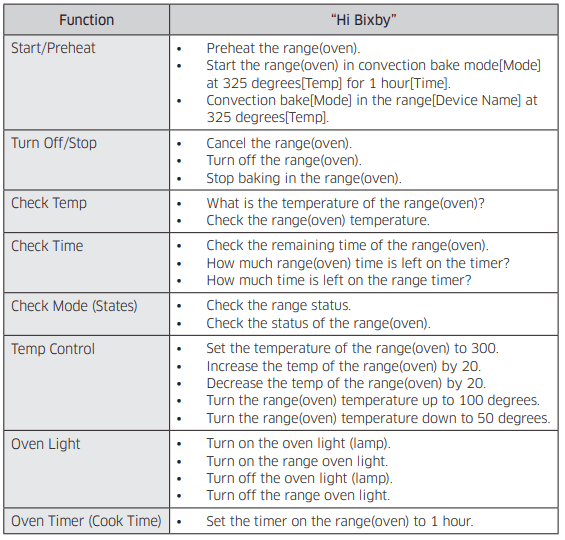
Amazon Alexa & Google Assistant
Samsung smart home appliances are supported by SmartThings skill in Alexa & action in Google Assistant.
Installation Guide
Here’s how to link SmartThings account into Amazon Alexa or Google Assistant. SmartThings App and Alexa App(or Google Assistant App) Should be installed on your phone.
1. Setup the supported devices to SmartThings.
2. After device setup, tap + button on the screen.
3. Tap ‘Voice assistant’ and link your Samsung account to Amazon Alexa. (or Google Assistant)
4. Check the devices are visible on Amazon Alexa app. Then account linking is complete. (Check the devices are visible and set the location(home&room) of devices in Google home app. Then account linking is complete.)
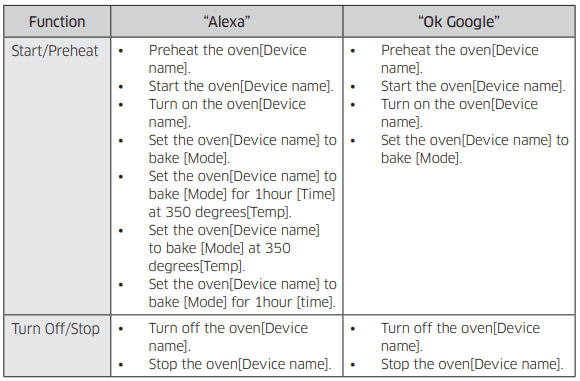
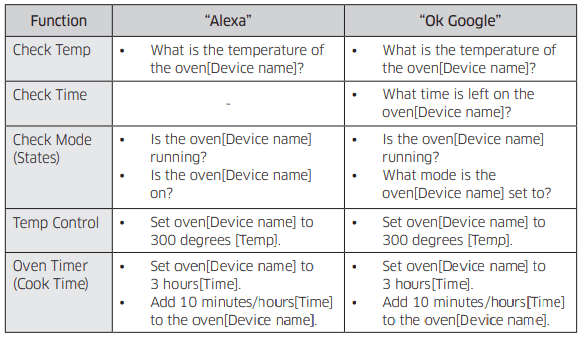
Using the options function
This function enables you to control various electronic control options. Refer to the following table for available options. The option menu is only available when the oven is not being used (not cooking).

Temp Adjust
The temperature in the oven has been calibrated at the factory. When first using the oven, be sure to follow recipe times and temperatures. If you think the oven is too hot or too cool, you can correct the temperature in the oven. Before correcting, test a recipe by using a temperature setting that is higher or lower than the recommended temperature. The baking results should help you to decide how much of an adjustment is needed. The oven temperature can be adjusted ±35 °F (±19 °C ).
How to correct the oven temperature
1. Press  Options for 3 seconds, and then Press 1 on the number pad.
Options for 3 seconds, and then Press 1 on the number pad.
2. Press Clock to select higher or lower than the current temperature.
Clock to select higher or lower than the current temperature.
3. Enter the adjustment you want to make using the number pad. (0-35).
4. Press START/SET to save the changes.
Temp Unit (Fahrenheit or Celsius temperature selection)
You can program the oven control to display the temperature in Fahrenheit or Celsius. The oven has been preset at the factory to display in Fahrenheit.
How to change the display from Fahrenheit to Celsius or Celsius to Fahrenheit
1. Press  Options for 3 seconds, and then Press 2 on the number pad.
Options for 3 seconds, and then Press 2 on the number pad.
2. Press 1 (Fahrenheit) or 2 (Celsius) on the number pad.
3. Press START/SET to save the changes.
Auto Conversion
When you use the auto conversion feature, the convection auto conversion feature will automatically convert entered regular baking temperatures to convection baking temperatures. If this feature is activated, the display will show the actual converted (reduced) temperature. For example, if you enter a regular recipe temperature of 350 °F and press Oven Start/Set, the display will show the converted temperature of 325 °F. (Default setting : off)
How to enable or disable the auto conversion feature
1. Press Options for 3 seconds, and then Press 3 on the number pad.
Options for 3 seconds, and then Press 3 on the number pad.
2. Press 1 (On) or 2 (Off) on the number pad.
3. Press START/SET to save the changes.
Time of Day (12hr/24hr)
The oven control can be programmed to display time of day in the 12-hour or 24- hour mode. The oven has been preset at the factory to display in the 12-hour mode.
How to change between the 12- and 24-hour time of day display
1. Press  Options for 3 seconds, and then Press 4 on the number pad.
Options for 3 seconds, and then Press 4 on the number pad.
2. Press 1 (12Hr) or 2 (24Hr) on the number pad.
3. Press START/SET to save the changes.
12-hour energy saving
If you accidently leave the oven on, this feature will automatically turn off the oven after 12-hours during baking functions or after 3 hours during a broil function. (Default setting : on)
How to turn the 12-hour energy saving feature on or off
1. Press Options for 3 seconds, and then Press 5 on the number pad.
Options for 3 seconds, and then Press 5 on the number pad.
2. Press 1 (12Hr) or 2 (--Hr) on the number pad.
3. Press START/SET to save the changes.
Sound On/Off
Using Sound On/OFF, you can set the oven controls to operate silently.
How to turn the sound on or off
1. Press Options for 3 seconds, and then Press 6 on the number pad.
Options for 3 seconds, and then Press 6 on the number pad.
2. Press 1 (On) or 2 (Off) on the number pad.
3. Press START/SET to save the changes.
Wi-Fi On/Off
You can turn the range’s Wi-Fi connection on or off.
How to turn the Wi-Fi on or off
1. Press Options for 3 seconds, and then Press 7 on the number pad.
Options for 3 seconds, and then Press 7 on the number pad.
2. Press 1 (On) or 2 (Off) on the number pad.
3. Press START/SET to save the changes.
Demo mode
This option is for use by retail establishments for display purposes only. (The heating element does not operate)
How to enable or disable the demo mode
1. Press Options for 3 seconds, and then Press 0 on the number pad.
Options for 3 seconds, and then Press 0 on the number pad.
2. Press 1 (On) or 2 (Off) on the number pad.
3. Press START/SET to save the changes.
Using the Sabbath feature
(For use on the Jewish Sabbath & Holidays)
You can use the Sabbath feature with baking only. The oven temperature may be set higher or lower after you set the Sabbath feature. (The oven temperature adjustment feature should be used only during Jewish holidays). The display, however, will not change and tones will not sound when a change occurs. Once the oven is properly set for baking with the Sabbath feature active, the oven will remain on continuously until the Sabbath feature is cancelled. This will override the factory preset 12-hour energy saving feature. If the oven light is needed during the Sabbath, press  before activating the Sabbath feature. Once the oven light is turned on and the Sabbath feature is active, the oven light will remain on until the Sabbath feature is turned off. If the oven light needs to be off, be sure to turn the oven light off before activating the Sabbath feature.
before activating the Sabbath feature. Once the oven light is turned on and the Sabbath feature is active, the oven light will remain on until the Sabbath feature is turned off. If the oven light needs to be off, be sure to turn the oven light off before activating the Sabbath feature.
How to use the Sabbath feature
1. Press Bake. The default temperature is 350 °F.
2. Enter the temperature you want, e.g., 375 °F, by using the number pad.
3. Press START/SET. The temperature display will start to change once the oven temperature reaches 175 °F.
4. Press Bake and Timer at the same time for 3 seconds. The display will show SAb. Once SAb appears in the display, the oven will not beep or display any further changes. You may change the oven temperature once baking has started. Remember that the oven will not beep or display any further changes once the Sabbath feature is engaged.
5. You can turn the oven off at any time by pressing OFF/CLEAR. This will turn only the oven off. If you want to deactivate the Sabbath feature, hold down Bake and Timer at the same time for 3 seconds. Sab will disappear from the display
Maintaining your appliance
Self-cleaning
This self-cleaning oven uses high temperatures (well above cooking temperatures) to burn off leftover grease and residue completely or reduce them to a finely powdered ash that you can wipe away with a damp cloth.
Before a self-cleaning cycle
• We recommend venting your kitchen with an open window or using a ventilation fan or hood during the selfcleaning cycle.
• Remove the wire rack, broil pan, broil pan insert, all cookware, and any aluminum foil from the oven.
• Wipe up debris from the oven bottom. (Fig. 1)
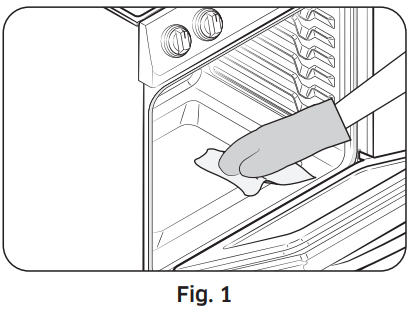
• The silver-colored oven racks can be self-cleaned, but they will darken, lose their luster, and become hard to slide.
• Residue on the front frame of the range and outside the gasket on the door will need to be cleaned by hand. Clean these areas with hot water, soap-filled steel-wool pads, or cleansers, such as Soft Scrub. Rinse well with clean water and dry.
• Do not clean the gasket. The fiberglass material of the oven door gasket cannot withstand abrasion. It is essential for the gasket to remain intact. If you notice it becoming worn or frayed, have it replaced. (Fig. 2)
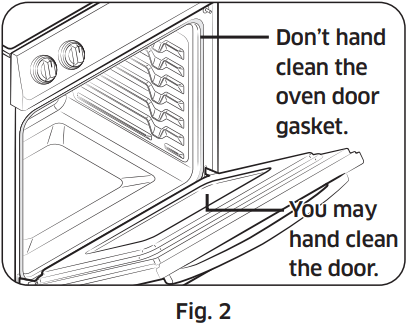
• Make sure the oven light bulb cover is in place and the oven light is off.
How to run a self-cleaning cycle
1. Select the length of time for the self-cleaning operation, e.g., 3 hours. Press Self Clean once for a 3 hour clean time, twice for a 5 hour clean time, or 3 times for a 2 hour clean time The default setting is 3 hours.
2. Press START/SET to start the self-cleaning cycle. The motor-driven door lock will engage automatically
3. When the self-cleaning cycle is done, End will appear in the display and the range will beep several times.
How to delay the start of self-cleaning
1. Press Self Clean. Select the desired self-clean time by pressing Self Clean.
2. Press Delay Start.
3. Enter the time you want the clean cycle to start.
4. Press START/SET. The display will show Delay, Self clean, and the Lock icon. The motor-driven door lock will engage automatically.
5. The Self-Cleaning cycle will turn on automatically at the set time.
How to turn off the self-cleaning feature
You may find it necessary to stop or interrupt a self-cleaning cycle due to smoke in the oven.
1. Press OFF/CLEAR.
2. You will be able to open the oven door once the oven has cooled down for approximately 1 hour
After a self-cleaning cycle
• You may notice some white ash in the oven. Wipe it up with a damp cloth after the oven cools. (If white spots remain, remove them with a soap-filled steel wool pad and rinse thoroughly with a vinegar and water mixture).
• If the oven is not clean after one cycle, repeat the cycle.
• You cannot set the oven for cooking until the oven is cool enough for the door to unlock.
Steam-cleaning
How to set the oven for steam-cleaning
For light cleaning, the steam-cleaning function saves time and energy. For heavierduty cleaning, use the self-cleaning function.
1. Remove all accessories from the oven.
2. Pour approximately 10 oz. (300 ml) of water onto the bottom of the empty oven and then close the oven door. Use normal water only, not distilled water.
3. Press Steam Clean.
4. Press START/SET. When the operation is complete, the display will blink and a beep will sound.
5. Press OFF.
6. Clean the oven’s interior. There will be a significant amount of water remaining on the bottom of the oven after a steam-cleaning cycle. Remove the residual water with a sponge or soft dry cloth.

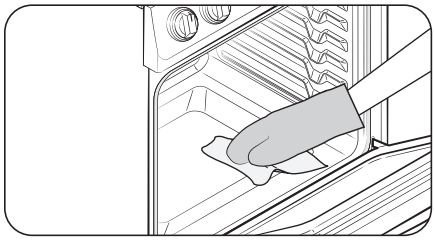
After a steam-cleaning cycle
• Take care when opening the door before a steam-cleaning procedure has ended. The water on the bottom is hot.
• Open the oven door and remove the remaining water with a sponge. Do not leave the residual water in the oven for any length of time. Wipe the oven clean and dry with a soft cloth. Do not forget to wipe under the oven door seal.
• Use a detergent-soaked sponge, a soft brush, or a nylon scrubber to wipe the oven interior. Remove stubborn residue with a nylon scourer. You can remove lime deposits with a cloth soaked in vinegar.
• If the oven remains dirty, you can repeat the procedure once the oven has cooled.
• For heavy residue, such as grease left over from roasting, we recommend that you rub detergent into the residue before activating the steam-cleaning function.
• After cleaning, leave the oven door ajar at a 15° angle to allow the interior enamel surface to dry thoroughly
Care and cleaning of the oven
Vent
• The vents are located at the back of the oven range.
• This area could become hot during oven use.
• It is normal for steam to come out of the vent.
• The vent is important for proper air circulation. Never block this vent.
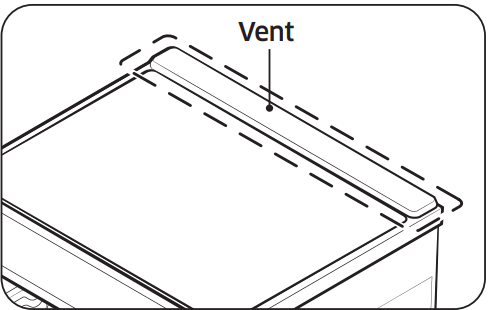
Cleaning painted parts and decorative trim
• For general cleaning, use a cloth with hot, soapy water.
• For more difficult residue and built-up grease, apply a liquid detergent directly onto the area and leave for 30 to 60 minutes. Wipe with a damp cloth and dry. Do not use abrasive cleaners on any of these surfaces. They can scratch.
Cleaning stainless steel surfaces
1. Shake the bottle of STAINLESS STEEL APPLIANCE CLEANER or POLISH well.
2. Place a small amount of STAINLESS STEEL APPLIANCE CLEANER or POLISH on a damp cloth or damp paper towel.
3. Clean a small area, rubbing with the grain of the stainless steel if applicable.
4. Dry and buff with a clean, dry paper towel or soft cloth.
5. Repeat as necessary.
Oven racks
If the racks are left in the oven during a self-cleaning cycle, their color will turn slightly blue and the finish will be dull. After the self-cleaning cycle is complete and the oven has cooled, rub the sides of the racks with wax paper or a cloth containing a small amount of oil. This will help the racks glide more easily on their tracks.
Air fry tray
To keep the Air fry tray clean, remove them from the cavity, and soak them in Lukewarm soapy water. Then, scour soil off of the Air fry tray using a plastic scouring pad.
Oven door
• Use soap and water to thoroughly clean the top, sides, and front of the oven door. Rinse well. You may use a glass cleaner on the outside glass of the oven door. DO NOT immerse the door in water. DO NOT spray or allow water or the glass cleaner to enter the door vents. DO NOT use oven cleaners, cleaning powders, or any harsh abrasive cleaning materials on the outside of the oven door.
• DO NOT clean the oven door gasket. The oven door gasket is made of a woven material, which is essential for a good seal. Care should be taken not to rub, damage, or remove this gasket.

Care and cleaning of the glass cooktop
Normal daily use cleaning
Use only a ceramic cooktop cleaner. Other creams may not be as effective. By following these steps, you can maintain and protect the surface of your glass cooktop.
1. Before using the cooktop for the first time, clean it with a ceramic cooktop cleaner. This helps protect the top and makes cleanup easier.
2. Daily use of a ceramic cooktop cleaner will help keep the cooktop looking new.
3. Shake the cleaning cream well. Apply a few drops of cleaner directly to the cooktop.
4. Use a paper towel or a cleaning pad for ceramic cooktops to clean the entire cooktop surface.
5. Use a dry cloth or paper towel to remove all cleaning residue. No need to rinse.
Removing burned-on residue
1. Allow the cooktop to cool.
2. Spread a few drops of ceramic cooktop cleaner on the entire burned residue area.
3. Using a cleaning pad for ceramic cooktops, rub the residue area, applying pressure as needed.
4. If any residue remains, repeat the steps listed above as needed.
5. For additional protection, after all residue has been removed, polish the entire surface by applying ceramic cooktop cleaner with a paper towel.

Removing heavy, burned-on residue
1. Allow the cooktop to cool.
2. Use a single-edge razor-blade scraper at approximately a 45° angle against the glass surface and scrape the soil. It will be necessary to apply pressure to remove the residue.
3. After scraping with the razor scraper, spread a few drops of ceramic cooktop cleaner on the entire burned residue area. Use a cleaning pad to remove any remaining residue. (Do not scrape the seal.)
4. For additional protection, after all residue has been removed, polish the entire surface by applying ceramic cooktop cleaner with a paper towel.
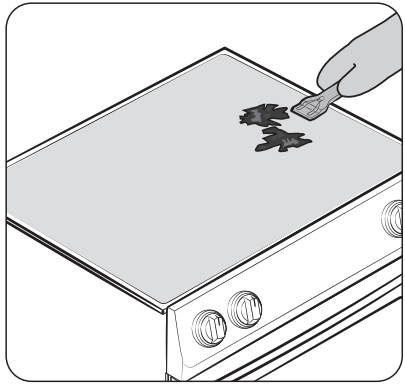
Removing metal marks and scratches
1. Be careful not to slide pots and pans across your cooktop. It will leave marks on the cooktop surface. You can remove these marks by applying ceramic cooktop cleaner with a cleaning pad for ceramic cooktops.
2. If pots with a thin overlay of aluminum or copper are allowed to boil dry, the overlay may leave black discoloration on the cooktop. You should remove this discoloration immediately or it may become permanent.
Cleaning the cooktop seal
To clean the seal around the edges of the glass, lay a wet cloth on it for a few minutes, then wipe clean with a nonabrasive cleaner.
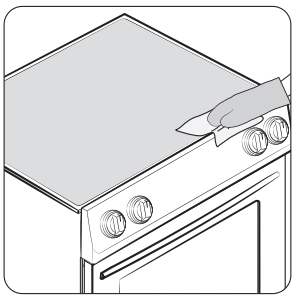
Potential for permanent damage to the glass surface
• Sugary spillovers (such as jellies, fudge, candy, syrups) or melted plastics can cause pitting of the surface of your cooktop. This is not covered under the warranty. You should clean the spill while it is still hot. Take special care when removing hot substances. Refer to the section below.
• When using a scraper, be sure it is new and the razor blade is still sharp. Do not use a dull or nicked blade.
Cleaning sugary spills and melted plastic
1. Turn off all surface units. Remove hot pans.
2. Wearing an oven mitt, use a single-edge razor blade scraper to move the spill to a cool area of the cooktop. Remove the spill with paper towels.
3. Any remaining spillover should be left until the surface of the cooktop has cooled.
4. Don’t use the surface units again until all of the residue has been completely removed.
Removing and reinstalling the oven door
How to remove the door
CAUTION :
• The door is very heavy. Be careful when removing and lifting the door. Do not lift the door by the handle.
• Turn the power OFF before removing the door.

1. Open the door completely.
2. Pull the hinge locks down toward the door frame to the unlocked position
3. Firmly grasp both sides of the door at the top.
4. Close the door to the door removal position, which is approximately
5 degrees from vertical (Fig. 1).

5. Lift door up and out until the hinge arm is clear of the slot (Fig. 2).
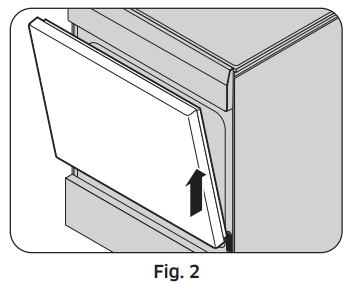
How to re-install the door

1. Firmly grasp both sides of the door at the top.
2. With the door at the same angle as the removal position, slide the indentation of the hinge arm into the bottom edge of the hinge slot. The notch in the hinge arm must be fully inserted into the bottom of the slot.

3. Open the door fully. If the door will not open fully, the indentation is not inserted correctly in the bottom edge of the slot.
4. Push the hinge locks up against the front frame of the oven cavity to the locked position.
5. Close the oven door.
Removing and reinstalling the storage drawer
1. Slide open the drawer until it stops.
2. Locate the roller guide clips on either side. Using both hands, pull down the left clip while lifting the right clip, and then remove the drawer.
3. Clean the drawer in warm, soapy water using a cloth or soft brush. Then, rinse and dry it thoroughly.
4. Put the drawer in the roller guides on either side, and then snap the clips into place.
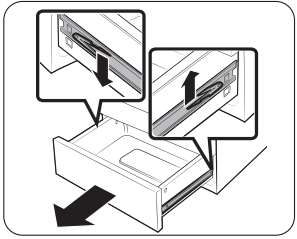
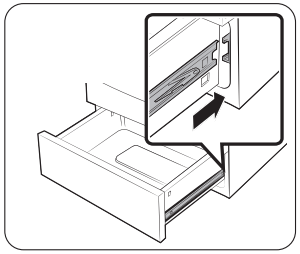
Changing the oven light
The oven light is a standard 40-watt appliance bulb. It will come on when the oven door is open. When the oven door is closed, press the pad to turn it on or off. It will not work during a self-cleaning cycle.
pad to turn it on or off. It will not work during a self-cleaning cycle.
1. Make sure the oven and the bulb are cool.
2. Unplug the range or disconnect the power.
3. Turn the glass bulb cover in the back of the oven counterclockwise to remove.
4. Turn the bulb counterclockwise to remove it from its socket.
5. Insert a new 40 watt appliance bulb, and then turn it clockwise to tighten. Replace the bulb cover by turning clockwise.
6. Plug in the range or reconnect the power.

Troubleshooting
Installation
Problem | Possible cause | Solution |
| The range is not level | The appliance has been installed improperly. | • Place the oven rack in the center of the oven. Place a level on the oven rack. Adjust the leveling legs at the base of the range until the oven rack is level. • Insure the floor is level and strong and stable enough to adequately support the range. |
| The floor is sagging or sloping. | Contact a carpenter to correct the situation | |
| The kitchen cabinets are not properly aligned and make the range appear to be not level. | Insure the cabinets are square and provide sufficient room for installation. | |
| The appliance must be accessed for servicing and cannot be moved easily. | The kitchen cabinets are not square and too close to the appliance. | Contact a builder or installer to make the appliance accessible |
| Carpet is interfering with movement of the range. | Provide sufficient space so the range can be lifted over the carpet. |
CONTROL DISPLAY
Problem | Possible cause | Solution |
| The display goes blank. | A fuse in your home may be blown or the circuit breaker tripped. | Replace the fuse or reset the circuit breaker. |
| The display flashes | There was a power failure. | Reset the clock |
COOKTOP
Problem | Possible cause | Solution |
| The surface units will not maintain a rolling boil or will not cook fast enough. | You may be using inappropriate cookware. | Use pans that are flat and match the diameter of the surface unit selected. |
| In some areas, the power (voltage) may be low. | Cover the pan with a lid until the desired heat is obtained | |
| The surface units will not turn on. | A fuse in your home may be blown or a circuit breaker may have tripped. | Replace the fuse or reset the circuit breaker. |
| The cooktop controls are set improperly. | Check if the correct control is set for the surface unit you are using. | |
| Areas of discoloration on the cooktop | Food spillover was not cleaned. | Refer to the section on the care and cleaning of the glass cooktop on page 52. |
| The surface is hot and the model features a lightcolored cooktop | This is normal. The surface may appear discolored when it is hot. This is temporary and will disappear as the glass cools. | |
| The surface unit frequently cycles on and off. | The element will cycle on and off to maintain the power setting. | This is normal operation, and not a system failure. Use the range as usual. |
| The surface unit stops glowing when changed to a lower setting. | This is normal. The unit is still on and hot. | |
| Scratches or abrasions on the cooktop surface. | The cooktop is being cleaned improperly. | Scratches are not removable. Tiny scratches will become less visible in time as a result of cleaning. Use ceramic glass top cleaning cream. Do not use chemical or corrosive agents. These agents may damage the surface of the product. |
| Cookware with rough bottoms was used on the cooktop or there were coarse particles (e.g., salt or sand) present between the cookware and the surface of the cooktop | To avoid scratches, follow the recommended cleaning procedures. Make sure cookware bottoms are clean before use, and use cookware with smooth bottoms. | |
| Cookware has been slid across the cooktop surface. | ||
| Brown streaks or specks. | Boilovers have been cooked onto the surface. | • Wait until the surface cools down. Then, use a single-edge razor-blade scraper at approximately a 45° angle against the glass surface to remove the soil. • See the section on the care and cleaning of the glass cooktop on page 52 |
| Areas of discoloration with metallic sheen. | Mineral deposits from water and food have been left on the surface of the cooktop | • Remove using a ceramic-glass cooktop cleaning cream. • Use cookware with clean, dry bottoms. Clean the cooktop with a ceramic cleaning agent regularly every week. |
| "Cracking" or "popping" sound. | This is the sound of the metal heating and cooling during both the cooking and self-cleaning functions. | This is normal operation, and not a system failure. Use the range as usual. |
OVEN
Problem | Possible cause | Solution |
| The oven will not turn on. | The range is not completely plugged into the electrical outlet. | Make sure the electrical plug is inserted into a live, properly grounded outlet. |
| A fuse in your home may be blown or a circuit breaker may have tripped | Replace the fuse or reset the circuit breaker. | |
| The oven controls have been set improperly | See the chapter on operating the oven starting on page 31 | |
| The oven is too hot. | Allow the oven to cool. | |
| Incomplete service wiring. | Call for service | |
| Power outage. | Check to see if the house lights will turn on. If necessary, call your local electric company for service. | |
| The oven light will not turn on. | The light bulb is loose or defective. | Tighten or replace the bulb. |
| The switch operating the light is broken. | Call for service | |
| The appliance will not turn on. | Incomplete service wiring.The appliance is not completely plugged into the electrical outlet or a fuse in your home may be blown or a circuit breaker may have tripped. | Make sure the power cord is plugged into a live, properly grounded outlet. Check the fuse and circuit breakers. |
| Incomplete service wiring. | Call for service. | |
| Power outage. | Check to see if the house lights will turn on. If necessary, call your local electric company for service. | |
| The oven smokes excessively during broiling | The oven controls have not been set properly. | Refer to the section on using the broiler starting on page 37. |
| The meat has been placed too close to the element. | Reposition the rack to provide proper clearance between the meat and the element. Preheat the broil element for searing. | |
| The meat has not been properly prepared. | Remove the excess fat from the meat. Cut away fatty edges that may curl, leaving the lean intact. | |
| Grease has built up on oven surfaces. | Regular cleaning is necessary when broiling frequently | |
| Food does not bake or roast properly. | The oven controls have not been set correctly. | See the chapter on operating the oven starting on page 31. |
| The oven rack has been positioned incorrectly or is not level | See the section on using the oven racks on page 34. | |
| Incorrect cookware or cookware of improper size is being used. | ||
| The oven sensor needs to be adjusted. | See the section on adjusting the thermostat on page 44. | |
| Food does not broil properly. | The serving size may not be appropriate. | Refer to the cooking guide for serving sizes on page 38, and then try again. |
| The rack has not been properly positioned. | See the broiling recommendation guide on page 38. | |
| The cookware is not suited for broiling | Use suitable cookware. | |
| In some areas, the power (voltage) may be low. | • Preheat the broil element for 10 minutes. • See the broiling recommendation guide on page 38. | |
| The oven temperature is too hot or too cold. | The oven sensor needs to be adjusted. | See the section on adjusting the thermostat on page 44. |
| The oven will not self-clean. | The oven temperature is too high to start a self-clean operation | Allow the range to cool and then reset the controls. |
| The oven controls have been set incorrectly. | See the section on selfcleaning on page 47 | |
| A self-cleaning cycle cannot be started if the oven lock feature has been activated or if a cooktop element is on. | Deactivate the oven lock (see page 31). Make sure all surface elements are turned off. | |
| Excessive smoking during a self-cleaning cycle. | There is excessive soiling in the oven. | Press OFF/CLEAR. Open the windows to rid the room of smoke. Wait until the selfcleaning cycle is cancelled. Wipe up the excessive soil and then start the selfcleaning cycle again. |
| The oven door will not open after a selfcleaning cycle | The oven is too hot. | Allow the oven to cool. |
| The oven is not clean after a self-cleaning cycle. | The oven controls were not set correctly | See the section on selfcleaning on page 47. |
| The oven was heavily soiled | Wipe up heavy spillovers before starting the selfcleaning cycle. Heavily soiled ovens may need to be selfcleaned again or for a longer period of time. | |
| Steam is coming out of the vent. | When using the convection feature, it is normal to see steam coming out of the oven vent. | This is normal operation and not a system failure. Use the range as usual. |
| As the number of racks or amount of food being cooked increases, the amount of visible steam will increase. | ||
| A burning or oily odor is coming from the vent. | This is normal in a new oven and will disappear in time. | • To speed the process, set a self-cleaning cycle for a minimum of 3 hours. • See the section on selfcleaning on page 47. |
| Strong odor. | An odor coming from the insulation around the inside of the oven is normal for the first few times the oven is used. | Operate the oven empty on the bake setting at 400 °F for 1 hour |
| Fan noise | A convection fan may automatically turn on and off | This is not a system failure but normal operation. |
| Oven racks are difficult to slide. | The shiny, silver-colored racks were cleaned in a selfcleaning cycle. | Apply a small amount of vegetable oil to a paper towel, and then wipe the edges of the oven racks with the paper towel. |
DRAWER
Problem | Possible cause | Solution |
| The drawer does not slide smoothly or drags. | The drawer is out of alignment. | Fully extend the drawer and push it all the way in. See the page 56. |
| The drawer is overloaded or the load is unbalanced | Reduce weight. Redistribute drawer contents. | |
| Excessive condensation in the drawer | There is liquid present in the drawer. | Remove the liquid. |
| Uncovered foods. | Cover food with a lid |
Information codes
Displayed Code | Possible cause | Solution |
| C-d0 | There is a short in the control key. | Press OFF/CLEAR, and then restart the oven. If the problem persists, disconnect all power to the range for at least 30 seconds and then reconnect the power. If this does not solve the problem, call for service. |
| C-d1 | The door lock is misaligned. | |
| C-F0 | This code occurs if communication between the Main and Sub PBA is interrupted. | |
| C-F2 | This code occurs if communication between the Main and Touch is interrupted. | |
| C-20 | The oven sensor is open when the oven is operating. | Press OFF/CLEAR, and then restart the oven. If the problem persists, disconnect all power to the range for at least 30 seconds and then reconnect the power. If this does not solve the problem, call for service. |
| There is a short in the Oven sensor. | ||
| C-21 | This code occurs if the internal temperature rises abnormally high. | |
| C-22 | The sub PCB sensor is open when the oven is operating. | |
| There is a short in the sub PCB sensor. | ||
| C-30 | The main PCB sensor is open when the oven is operating. | |
| There is a short in the main PCB sensor | ||
| C-31 | This code occurs if the PCB temperature rises abnormally high. | Call for service. |
| bAd LinE | This error message appears if the power cord is installed improperly. | If the power connection is plugged in improperly, “bAd LinE” appears on the display. Reconnect the power connection properly, and the message disappears. |
| C-A2 | This code occurs if the sub PCB temperature rises abnormally high. | Press OFF/CLEAR, check the vent. If the vent is closed, never block the vent by anything. After cooling the oven, restart the oven. If this does not solve the problem, call for service. |
COOKTOP
Displayed code | Possible cause | Solution |
 | This code occurs if communication between the Main and Inverter PBA is interrupted. | Turn the knob to Off, and then turn it to the setting you want again. If the problem persists, disconnect all power to the range for at least 30 seconds and then reconnect the power. If this does not solve the problem, call for service. |
 | The top sensor is open when the burner is operating. | Call for service |
| The top sensor is short when the burner is operating. | ||
 | The IGBT sensor is open when the burner is operating. | |
| The IGBT sensor is short when the burner is operating. | ||
 | This code occurs if the DC fan motor is open or locked. | |
 | Displayed if the cookware on an element is unsuitable or too small or no cookware has been placed on the cooking zone. | Check the cookware |
 | Displayed if an element knob was set to an On position when the Sabbath or Self-clean mode has ended or been cancelled, and the burner was not able to detect pan during 1 minute. | To return the display to normal and use the cooktop, turn the knob to the Off position. |
 | This code appears if the internal temperature of a burner rises abnormally high. | Turn the knob to Off, and then turn it to the setting you want again. If the problem persists, disconnect all power to the range for at least 30 seconds and then reconnect the power. If this does not solve the problem, call for service. |
See other models: NE63B8211SS/AA QN55LS03BAFXZA SM-G715FZKDXSG SM-T575NZKAXSG RF30BB660012AA
